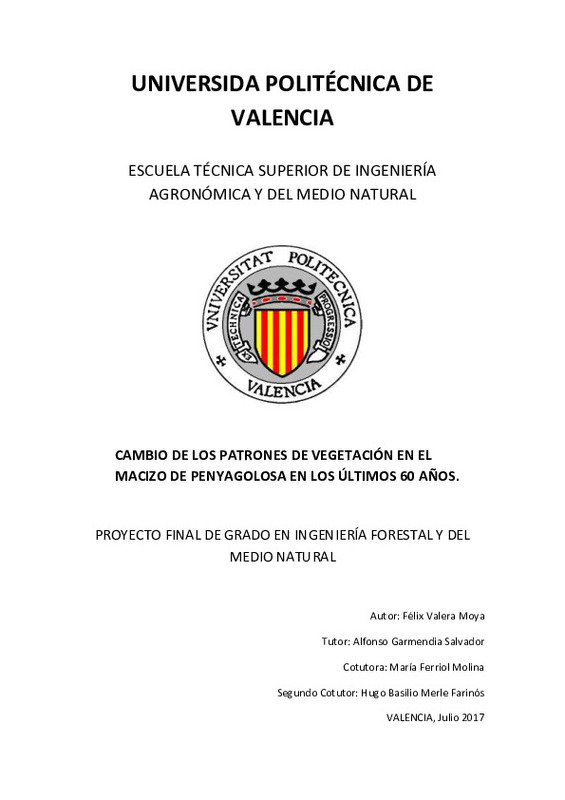|
Resumen:
|
[ES] El presente Trabajo Final de Carrera, trata de ver la evolución del área ocupada por distintas
formaciones vegetales y/o tipos de uso de suelo del Macizo de Penyagolosa.
Para ello se realizará un trabajo de ...[+]
[ES] El presente Trabajo Final de Carrera, trata de ver la evolución del área ocupada por distintas
formaciones vegetales y/o tipos de uso de suelo del Macizo de Penyagolosa.
Para ello se realizará un trabajo de fotointerpretación, a partir de una serie de fotografías aéreas
correspondientes a los años 1956, 1985 y la actualidad. Estas fotografías aéreas cubren todo el
área de estudio y se han obtenido a partir de los fotogramas disponibles: los de 1956
suministrados en formato .JPG y con una escala media de 1:33000, por el Centro Cartográfico y
Fotográfico del Ejercito del Aire (CECAF) pertenecientes al Vuelo Americano, serie B, de 1956-
1957, los fotogramas de 1985 en formato .ECW con una escala media de 1:30000
pertenecientes del Centro Nacional de Información Geográfica (CNIG), correspondiente al Vuelo
Nacional 1980-1985 y la fotografía aérea actual obtenida del Instituto Geográfico Nacional (IGN).
Para poder procesar ambos conjuntos de fotogramas como fotografías aéreas con un sistema
de información geográfica, ha sido necesario aplicar un ortorectificado por separado para los
fotogramas de ambos años, mediante el software de fotogrametría ERDAS, para finalmente
obtener las dos fotografías aéreas georreferenciadas, que incluyen todas las fotografías de cada
año, en el sistema ETRS89 huso 30. Esta parte del trabajo ya ha sido realizada en un proyecto
anterior inédito del grupo de investigación.
Con estas capas se realizará la digitalización de las diferentes formaciones vegetales
distinguibles en las fotografías aéreas utilizando un sistema de información geográfica, para el
estudio de la evolución de las comunidades vegetales, en una superficie de 14.000 ha.
Una segunda fase del estudio será ir al campo a reconocer las diferentes formaciones
identificadas para comprobar su correcta identidad florística.
En la tercera fase se verán las diferencias entre formaciones observadas en las fotos aéreas,
comparando a su vez con fotos históricas de diferentes fechas realizadas a pie de campo.
Los resultados se representarán cartográficamente con el máximo de detalle posible a partir de
la fotografía aérea.
[-]
[EN] The present Final Work, tries to see the evolution of the area occupied by different plant
formations and / or types of land use of the Penyagolosa Massif.
To do this, a photointerpretation will be carried out, based ...[+]
[EN] The present Final Work, tries to see the evolution of the area occupied by different plant
formations and / or types of land use of the Penyagolosa Massif.
To do this, a photointerpretation will be carried out, based on a series of aerial photographs
corresponding to the years 1956, 1985 and today. These aerial photographs cover the entire
study area and were obtained from the available frames: those of 1956 supplied in .JPG format
and with an average scale of 1: 33000, by the Cartographic and Photographic Center of the Air
Force (CECAF ) Belonging to the American Flight, series B, from 1956-1957, the 1985 frames in
.ECW format with an average scale of 1: 30000 belonging to the National Geographic
Information Center (CNIG), corresponding to the National Flight 1980-1985 and Current aerial
photography obtained from the National Geographic Institute (IGN). In order to process both
sets of frames as aerial photographs with a geographic information system, it was necessary to
apply a separate orthorectification for the frames of both years, using ERDAS photogrammetry
software, to finally obtain the two georeferenced aerial photographs, which include All the
photographs of each year, in the system ETRS89 spindle 30. This part of the work has already
been done in an unpublished previous project of the research group.
With these layers the digitization of the different vegetal formations distinguishable in the aerial
photographs will be realized using a geographic information system, for the study of the
evolution of the vegetal communities, in an area of 14,000 ha.
A second phase of the study will be to go to the field to recognize the different formations
identified to verify its correct floristic identity.
In the third phase you will see the differences between formations observed in the aerial photos,
comparing in turn with historical photos of different dates taken at the foot of the field.
The results will be represented cartographically with the maximum possible detail from aerial
photography.
[-]
|








